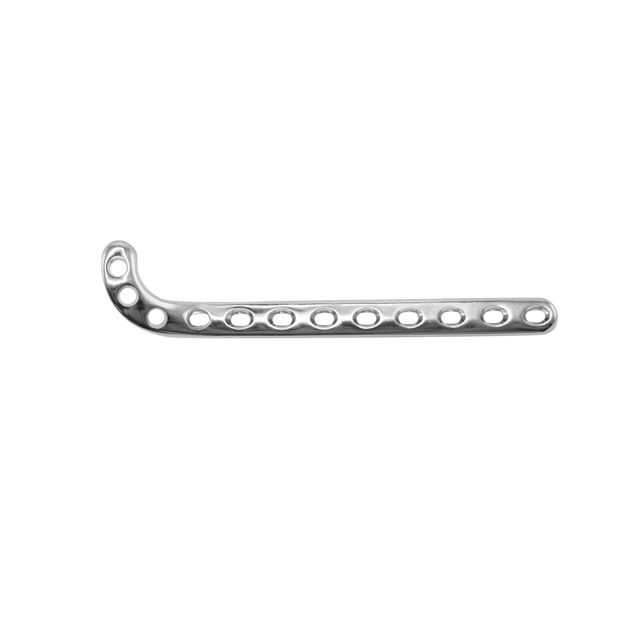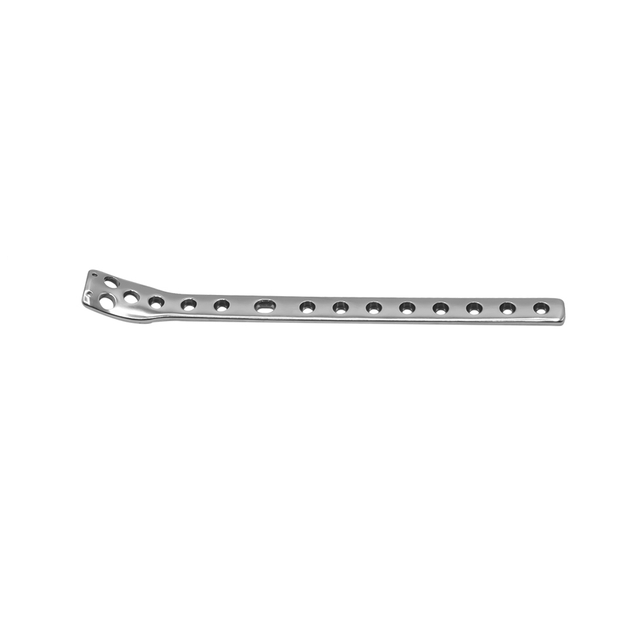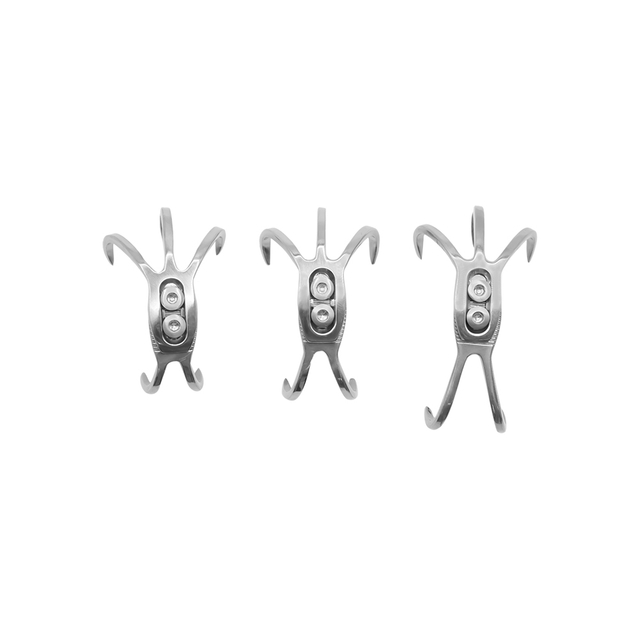What are Large Fragment?
Large Fragment refers to a group of bone fixation implants used in orthopedic surgery to treat fractures of the long bones, such as the femur (thigh bone), tibia (shin bone), and humerus (upper arm bone).
These implants are designed to stabilize the fracture by bridging the gap and allowing the bone to heal in the correct position. Large Fragment implants typically consist of metal plates and screws that are surgically implanted on the bone's surface to hold the bone fragments in place.
The plates and screws are larger and stronger than those used in Small Fragment implants, as they need to support more weight and withstand greater forces. Large Fragment implants are typically used in more severe fractures that require more extensive stabilization.
Materials of the locking plate?
Locking plates are typically made of biocompatible materials such as titanium, titanium alloy, or stainless steel. These materials have excellent strength, stiffness, and corrosion resistance, making them ideal for use in orthopedic implants. In addition, they are inert and do not react with body tissues, reducing the risk of rejection or inflammation. Some locking plates may also be coated with materials such as hydroxyapatite or other coatings to improve their integration with bone tissue.
Which plate is better titanium or stainless steel?
Both titanium and stainless steel plates are commonly used in orthopedic surgeries, including for locking plates. The choice between the two materials depends on several factors, including the type of surgery, the patient's medical history and preferences, and the surgeon's experience and preference.
Titanium is a lightweight and strong material that is biocompatible and resistant to corrosion, making it an excellent choice for medical implants. Titanium plates are less stiff than stainless steel plates, which can help reduce stress on the bone and promote healing. Additionally, titanium plates are more radiolucent, which means they do not interfere with imaging tests such as X-rays or MRI.
Stainless steel, on the other hand, is a stronger and stiffer material that is also biocompatible and resistant to corrosion. It has been used in orthopedic implants for decades and is a tried-and-true material. Stainless steel plates are less expensive than titanium plates, which can be a consideration for some patients.
Why titanium plates are used in surgery?
Titanium plates are often used in surgery because of their unique properties that make them an ideal material for medical implants. Some of the benefits of using titanium plates in surgery include:
Biocompatibility: Titanium is highly biocompatible, which means that it is unlikely to cause an allergic reaction or be rejected by the body's immune system. This makes it a safe and reliable material for use in medical implants.
Strength and durability: Titanium is one of the strongest and most durable metals, which makes it an ideal material for implants that need to withstand the stresses and strains of everyday use.
Corrosion resistance: Titanium is highly resistant to corrosion and is less likely to react with bodily fluids or other materials in the body. This helps to prevent the implant from corroding or degrading over time.
Radiopacity: Titanium is highly radiopaque, which means that it can be easily seen on X-rays and other imaging tests. This makes it easier for doctors to monitor the implant and ensure that it is functioning properly.
What are locking plates used for?
Locking plates are used in orthopedic surgeries to provide stability and support to bones that are fractured, broken, or weakened due to disease or injury.
The plate is attached to the bone using screws, and the screws lock into the plate, creating a fixed-angle construct that provides strong support for the bone during the healing process. Locking plates are commonly used in the treatment of fractures of the wrist, forearm, ankle, and leg, as well as in spinal fusion surgeries and other orthopedic procedures.
They are particularly useful in cases where the bone is thin or osteoporotic, as the locking mechanism of the plate provides added stability and reduces the risk of implant failure.
How does a bone plate work?
A bone plate is a medical device used to stabilize bone fractures during the healing process. It is a flat piece of metal, typically made of stainless steel or titanium, that is attached to the surface of the bone using screws. The plate acts as an internal splint to hold the fractured bone fragments in proper alignment and provide stability during the healing process. The screws secure the plate to the bone, and the plate holds the bone fragments in the correct position. Bone plates are designed to provide rigid fixation and prevent motion at the fracture site, which allows the bone to heal properly. Over time, the bone will grow around the plate and incorporate it into the surrounding tissue. Once the bone has fully healed, the plate may be removed, although this is not always necessary.
Do locking screws provide compression?
Locking screws do not provide compression, as they are designed to lock into the plate and stabilize the bone fragments through fixed-angle constructs. Compression is achieved by using non-locking screws that are placed in compression slots or holes of the plate, allowing for compression of the bone fragments as the screws are tightened.
Do plates and screws hurt?
It is normal to experience pain and discomfort after having plates and screws inserted during surgery. However, pain should subside over time as the body heals and the surgical site recovers. Pain can be managed through medication and physical therapy. It is important to follow the post-operative instructions provided by the surgeon and report any persistent or worsening pain to the medical team. In rare cases, hardware (plates and screws) can cause discomfort or pain, and in such instances, the surgeon may recommend hardware removal.
How long does it take for bones to heal with plates and screws?
The time it takes for bones to heal with plates and screws can vary depending on the severity of the injury, the location of the injury, the type of bone, and the age and overall health of the patient. In general, it can take several weeks to several months for bones to heal completely with the help of plates and screws.
During the initial recovery period, which typically lasts around 6-8 weeks, the patient will need to wear a cast or brace to keep the affected area immobilized and protected. After this period, the patient may begin physical therapy or rehabilitation to help improve range of motion and strength in the affected area.
However, it's important to note that the healing process is not complete once the cast or brace is removed, and it can take several more months for the bone to fully remodel and regain its original strength. In some cases, patients may experience residual pain or discomfort for several months after the injury, even after the bone has healed.
English
Français
Русский
Español
العربية
Português
Deutsch
italiano
日本語
한국어
Nederlands
Tiếng Việt
ไทย
Polski
Türkçe
አማርኛ
ພາສາລາວ
ភាសាខ្មែរ
Bahasa Melayu
ဗမာစာ
தமிழ்
Filipino
Bahasa Indonesia
magyar
Română
Čeština
Монгол
қазақ
Српски
हिन्दी
فارسی
Kiswahili
Slovenčina
Slovenščina
Norsk
Svenska
українська
Ελληνικά
Suomi
Հայերեն
עברית
Latine
Dansk
اردو
Shqip
বাংলা
Hrvatski
Afrikaans
Gaeilge
Eesti keel
Māori
नेपाली
Oʻzbekcha
latviešu
অসমীয়া
Aymara
Azərbaycan dili
Bamanankan
Euskara
Беларуская мова
भोजपुरी
Bosanski
Български
Català
Cebuano
Corsu
ދިވެހި
डोग्रिड ने दी
Esperanto
Eʋegbe
Frysk
Galego
ქართული
guarani
ગુજરાતી
Kreyòl ayisyen
Hausa
ʻŌlelo Hawaiʻi
Hmoob
íslenska
Igbo
Ilocano
Basa Jawa
ಕನ್ನಡ
Kinyarwanda
गोंगेन हें नांव
Krio we dɛn kɔl Krio
Kurdî
Kurdî
Кыргызча
Lingala
Lietuvių
Oluganda
Lëtzebuergesch
Македонски
मैथिली
Malagasy
മലയാളം
Malti
मराठी
ꯃꯦꯇꯥꯏ (ꯃꯅꯤꯄꯨꯔꯤ) ꯴.
Mizo tawng
Chichewa
ଓଡ଼ିଆ
Afaan Oromoo
پښتو
ਪੰਜਾਬੀ
Runasimi
Gagana Samoa
संस्कृत
Gaelo Albannach
Sepeti
Sesotho
chiShona
سنڌي
Soomaali
Basa Sunda
Wikang Tagalog
Тоҷикӣ
Татарча
తెలుగు
ትግንያውያን
Xitsonga
Türkmençe
संस्कृत
ئۇيغۇرچە
Cymraeg
isiXhosa
ייִדיש
Yorùbá
isiZulu





















